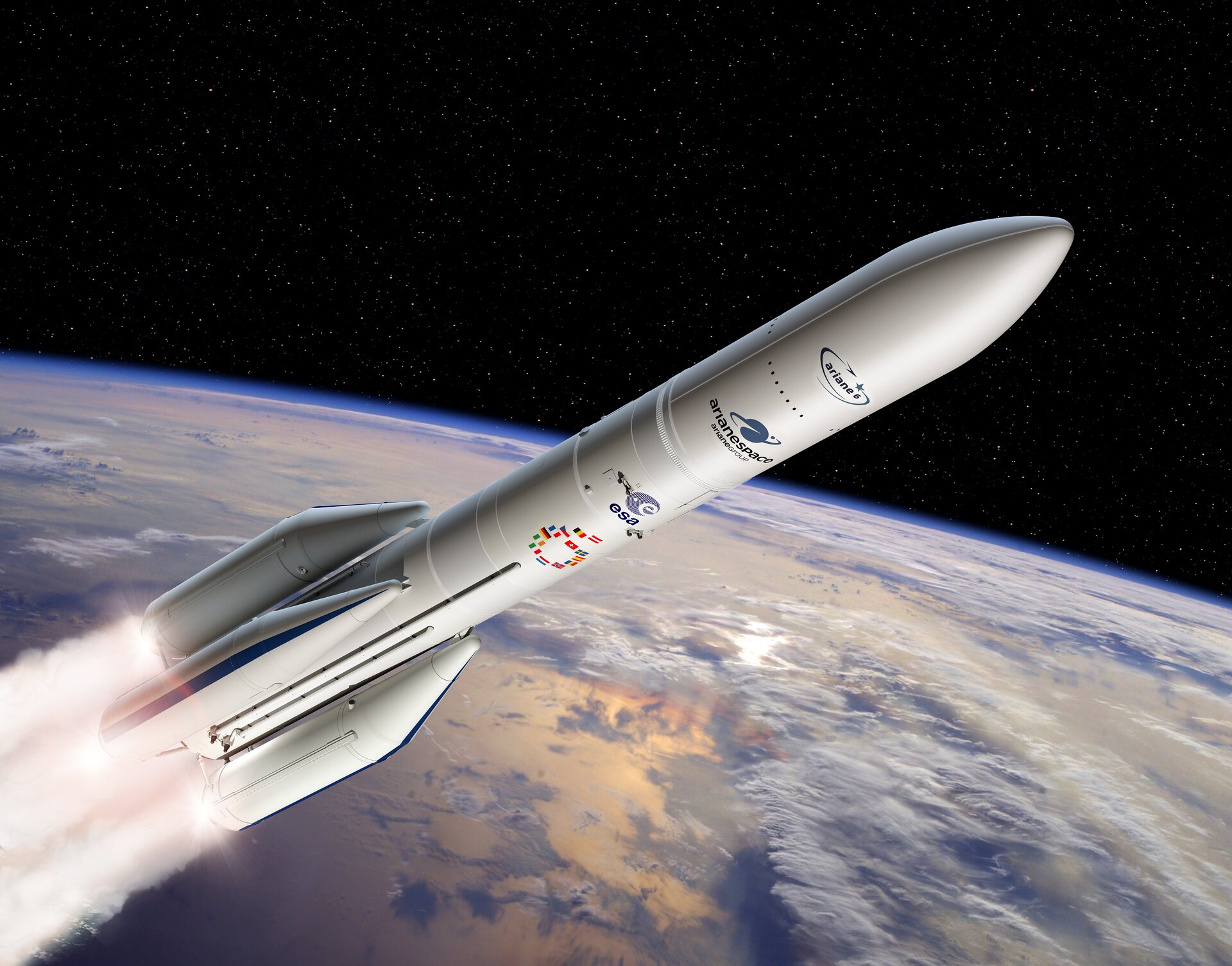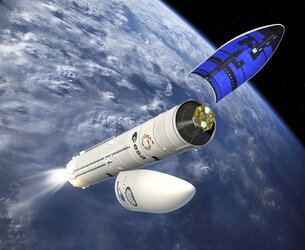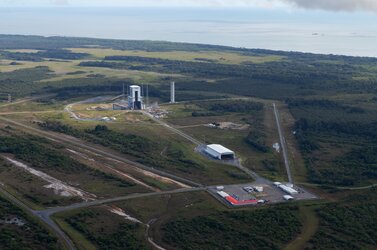Ariane 6 overview
Europe’s new rocket Ariane 6 will be capable of a wide range of missions.

Ariane 6 will be available in two versions depending on the performance required: a version with two boosters, called Ariane 62, and Ariane 64 with four boosters.
- Ariane 62 can launch payloads of approximately 4.5 tonnes into geostationary transfer orbit or 10.3 tonnes into low Earth orbit.
- Ariane 64 can launch payloads of approximately 11.5 tonnes into geostationary transfer orbit and 21.6 tonnes into low Earth orbit.
At over 60 metres tall, Ariane 6 will weigh almost 900 tonnes when launched with a full payload – roughly equivalent to one and a half Airbus A380 passenger aircraft.
For the development of Ariane 6, ESA is working with an industrial network of several hundred companies in 13 European countries, led by prime contractor ArianeGroup.
France’s space agency, CNES, built, runs and maintains the Ariane 6 launch facilities at Europe’s Spaceport in French Guiana.
Flexibility
Ariane 6 will have the flexibility to launch both heavy and light payloads to a wide range of orbits for applications such as Earth observation, telecommunication, meteorology, science and navigation.
Payload carriers allow small satellites lighter than 200 kg to ride 'piggyback' on the launch of the main payload, efficiently combining payloads in the same mission.
These adapters have been developed through ESA’s Light satellite Low-cost Launch opportunity initiative.
A rideshare ‘multiple launch’ service for small satellites provides cost-effective opportunities for small companies to access the growing space industry.
Ariane 6 elements

Ariane 6 comprises three stages: two or four boosters, and a main and upper stage – known together as the central core.
The main stage together with the solid rocket boosters propels Ariane 6 in the first phase of flight. The core stage is powered by the liquid-fuelled Vulcain 2.1 – an upgraded engine derived from Ariane 5’s Vulcain 2 – and the P120C boosters provide additional thrust at liftoff.
The upper stage is powered by the reignitable Vinci engine fuelled by cryogenic liquid oxygen and hydrogen. This allows Ariane 6 to reach a range of orbits on a single mission to deliver more payloads. The upper stage will typically burn multiple times to reach the required orbits. After separation of the payload, there will be a final burn to deorbit the upper stage and reduce space debris.
The fairing, a nose cone that splits into two vertically, at the top of Ariane 6 comes in two sizes: 20 m and a shorter 14 m version. Both are 5.4 m in diameter and made of carbon fibre-polymer composite. The fairing protects satellites from the thermal, acoustic and aerodynamic stresses on the ascent to space.
Launch zone

Ariane 6 will be launched from Europe’s Spaceport in French Guiana from a new launch site 4 km west of the Ariane 5 launch pad. The main structures include the launcher assembly building, the mobile gantry and launch pad.
Europe's Spaceport covers 170 hectares, with buildings on 18 hectares. Its location is ideal; with open sea to the north and east, and the town of Kourou 17 km distant, flight safety constraints are minimised. And, because the Spaceport is just 5° north of the equator, flights to the east gain very nearly the maximum possible speed boost from the Earth's rotation, increasing payload performance for any rocket – much more than from more northerly or southerly locations.

- The launcher assembly building is 20 m tall, 112 m long, and 41 m wide, located 1 km away from the launch zone. It is used for horizontal integration and preparation before rollout to the launch zone.

- The mobile gantry is a 90 metre-high mobile metallic structure weighing 8200 tonnes when fully equipped, that rolls on rails. It weighs 8200 tonnes, which is over 8 million kilograms, and is nearly one thousand tonnes heavier than the Eiffel Tower – equivalent to more than 1600 elephants. The mobile gantry is equipped with platforms to work on the rocket on the launch pad. The structure stores and protects Ariane 6 until it is retracted before launch.

- The launch pad extends 28.5 m below Ariane 6 and is 200 m wide, formed with enough concrete to fill 67 Olympic sized swimming pools – approximately 167 500 cubic metres. It includes a 700 tonne steel launch table to support Ariane 6. Steel deflectors funnel the fiery plumes of Ariane 6 at liftoff into the exhaust tunnels under the launch table. Four lightning protection masts and a water tower for the sound suppressing deluge systems are also part of the launch pad.
Background and responsibilities

The decision to start development of Ariane 6 was taken at the ESA Council at Ministerial level meeting in December 2014, the main motivation being to maintain Europe’s leadership in the fast-changing commercial launch service market while also responding to the needs of European independence in accessing and using space.
ESA’s role in the development of Ariane 6 is to oversee the process of procurement, as well as being in charge of the architecture of the overall launch system.
Industries across Europe are in charge of building the launch vehicle and its components, with ArianeGroup as prime contractor and design authority. The P120C solid booster that is used by both Ariane 6 and Vega-C rockets, is developed by ArianeGroup and Avio, through their joint venture Europropulsion.
While ESA provides the launch system requirements for institutional missions, industry is responsible for identifying commercial market requirements, given its future responsibility in the commercial use of the launch system.
Further information
Follow the Ariane 6 programme on X via @ESA_transport


Access the video














 Germany
Germany
 Austria
Austria
 Belgium
Belgium
 Denmark
Denmark
 Spain
Spain
 Estonia
Estonia
 Finland
Finland
 France
France
 Greece
Greece
 Hungary
Hungary
 Ireland
Ireland
 Italy
Italy
 Luxembourg
Luxembourg
 Norway
Norway
 The Netherlands
The Netherlands
 Poland
Poland
 Portugal
Portugal
 Czechia
Czechia
 Romania
Romania
 United Kingdom
United Kingdom
 Slovenia
Slovenia
 Sweden
Sweden
 Switzerland
Switzerland





































